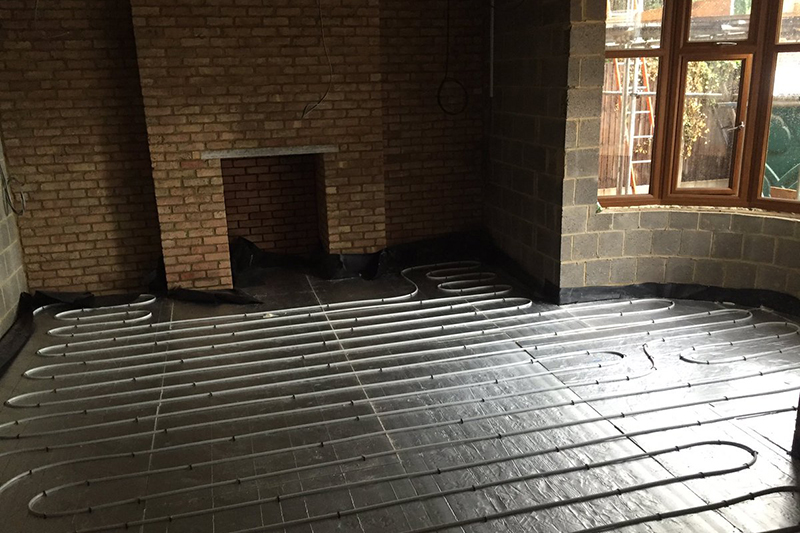
Plumbers who already work with underfloor heating know how popular it’s becoming. So, what’s driving this growth, and how are installers taking advantage of it? Lee Halstead, Technical Engineer at RWC UK, provides some answers.
Underfloor heating (UFH) has been steadily gaining popularity, with various reports highlighting year on year growth. One of them – the ‘Underfloor Heating Market by Component – Global Forecast 2023’ – believes sales will have grown 67% between 2016 and 2023. It suggests there’s lots of potential, especially with homeowners on the look-out for smart, energy efficient heating that brings other benefits too. The fact is, UFH ticks all the boxes – and more – but it’s just less well understood than more conventional heating.
To take advantage of this potential, plumbers need to do two things. First, get more familiar with the technology and its benefits. And second, explain these benefits to homeowners.
So how does UFH work? It does exactly what it says on the tin. Specially designed underfloor pipes carry relatively low temperature water (typically between 35 and 45°C). This water then heats the floor up to between 25 and 27°C, and effectively radiates heat up through the floor and into the room. In contrast, conventional radiators carry water at 75°C, and work by convection. Both can create comfortable homes, but as UFH heats larger areas, at lower temperatures, we believe it’s clear which is the more energy efficient.
Smart savings
Understandably, it’s this efficiency which most attracts homeowners. Moreover, most UFH solutions are compatible with smart thermostats and controls, so can be used to create multi-zone systems. For example, the JG Aura range, part of JG Underfloor, offers smart zonal heating that is controllable by the JG Aura app. The net result of combining UFH with smart technology is a more customised heating solution, as well as additional cost-savings.
The first of these – customised heating – is something people really feel. The second – cost-savings – is something they see in their energy bills. Over time, these really add up and help pay back the cost of installation which can be a little higher than for more conventional heating systems.
Beyond savings, UFH has many additional benefits but, like the underfloor pipework, these aren’t always immediately visible.
Aesthetic benefits
It’s odd to say that UFH looks great, because you can’t actually see it. And that’s precisely the point. There are no externally visible pipes, and no bulky radiators. Rooms and walls are clear, giving homeowners less clutter and more space. UFH is also a lot quieter, with no gurgling pipes and creaking floors as water expands and contracts. If it wasn’t for the warmth, you’d hardly know it was there.
Good for health and well-being
UFH uses radiant heat, which results in lower moisture levels and less air movement than with convection. As a consequence, there’s less movement of airborne dust allergens, bringing potential health benefits for those with allergies. Similarly, the absence of radiators eliminates the risk of children getting burnt or crashing into sharp edges.
The green factor
Finally, there’s the question of sustainability and future-proofing. We know that gas is on borrowed time, with 2025 marking the end of gas boilers in new builds. There’s also the Government’s ambitious target of net-zero emissions by 2050. One of the most anticipated replacement technologies – low-carbon heat pumps – is coming fast, which is even more great news for UFH installers. There’s huge potential out there on everything from new build through to retrofit and renovation projects.
How hard can it be to install?
UFH is a different approach to heating, but in terms of installation it’s not as complex as many people imagine, or at least it shouldn’t be. The principles are simple, the technology has come on leaps and bounds, and there are many products out there to choose from.
As with anything, it pays to look for reliable brands with extra features and support around the package. For example, the JG Underfloor brand includes the Polybutylene JG Layflat pipe which has been designed for flexibility, simplifying the pipe laying process. The JG team is also available to provide technical help and support, including free CAD drawings and installation advice.
Certainly, there are a few additional things to consider with UFH, including using conduit pipes to help protect against accidental and heat damage, while it’s also essential to remove any air in the system and pressure test it with water. But these are easy to learn and to do, and by liaising with manufacturers, jobs can be delivered quickly, efficiently and cost-effectively.
Generally speaking, UFH is just another heating technology. And with a little care and planning, it’s one that could help plumbers and installers keep busy for years.












